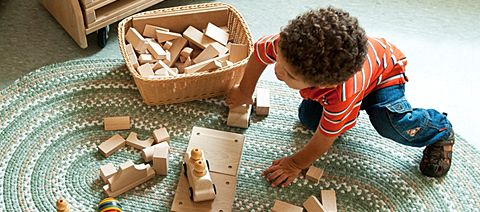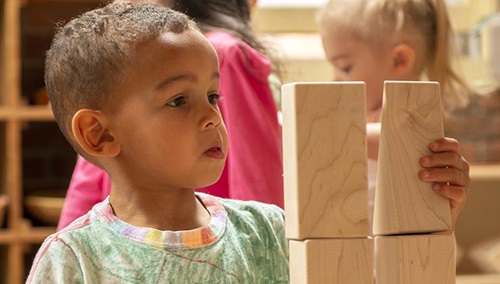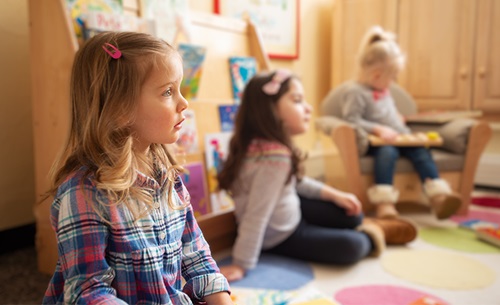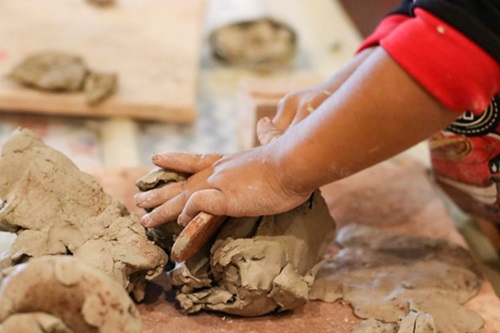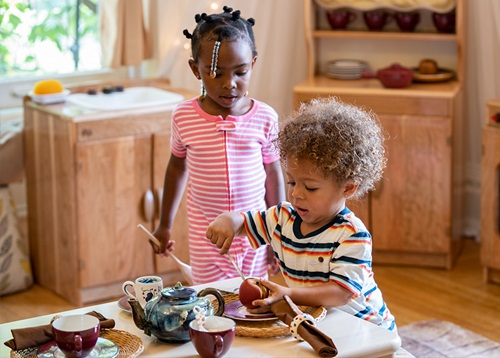Criteria for Selecting Play Equipment
| March 2011“No amount of planning and equipment can replace genuine love. But a versatile piece of sturdy equipment geared to the child’s growth—not a number of flimsy, highly differentiated ones—will be your helper in loving support of the child and will see you through thick and thin.”
WHAT MAKES GOOD PLAYTHINGS?
- Simplicity of design
- Involve child in play
- Versatile in use
- Easily comprehended & manipulated
- Encourage cooperative play
- Material that is warm and pleasant to touch
- Durable
- Work as intended
- Safe
- Generous in proportion and quantity
- Price based on durability and design
DESIGN
Simplicity is the key. A young child’s playthings should be as free from detail as possible, allowing her to express herself by creating her own childlike world. Too much detail limits a child. The more versatile and unspecialized playthings are, the more creative and absorbing the play. Unit blocks, one of the most essential pieces of equipment for the preschooler, are perhaps the best example of “unstructured” toys. These permit a child to create as he wills, with the next step determined by him, not by the structure of the play material. Blocks, construction sets, clay, sand, and paints allow the imagination free rein and are basic playthings.
CHILD INVOLVEMENT
A good plaything should involve the whole child—body, mind, and spirit. Such a toy will stimulate children to do things for themselves. Equipment which makes the child a spectator, such as a windup dog which turns somersaults, may entertain for the moment, but has little or no play value. Their play equipment should encourage children to explore and create, or offer the opportunity for dramatic play. Materials which allow a child only a passive role are not tools of play, but objects of diversion.
VERSATILITY
Some equipment in the classroom must be provided to satisfy the need of growing muscles to push, climb, run, bend, and lift. A gym that can keep half a dozen children playing at one time is a valuable asset. Hollow blocks use large muscles, too. The wood used for hollow blocks must stand rough usage and have all-rounded edges, satisfying to handle. Their design must allow small hands to get a firm grip. Such blocks involve the whole child and are ideal for group use in dramatic play.
COOPERATIVE PLAY
Teachers should ask themselves “Will the equipment encourage cooperative play?” Happy hours of self-forgetful play with peers can be a cornerstone of a child’s life. A child’s play experiences are foundational for every area of his adult life, and we should provide the opportunity for it to take place. A housekeeping corner with child-size furniture fulfills both the need for dramatization and cooperative play. You may see your children create a train out of hollow blocks and thin air!
MATERIALS
Children love their playthings, and should be able to depend on them. They need time to develop a relatedness to them, time for the playthings to become trustworthy friends. Playthings which do not last are educationally as well as economically unsound. Wood and cloth are materials children find particularly appealing. A wooden toy has a warm, friendly feel that is satisfying and reassuring to small hands. Wood like maple, hard and split-resistant, also fulfills the requirement of durability. A solid, generously proportioned wooden truck will afford many miles to the muscle, providing all its materials—wooden body, rubber wheels, bearings, and steel axles—are selected with real large-muscle use in mind.
FUNCTIONALITY
The playthings’ materials must also insure that the toys really “work.” What frustration when a cupboard door won’t shut, or the wheels on a truck stop turning! Children feel insulted when given “kids’ stuff.” The tools at the workbench should be real tools, not cheap copies sure to break on a real job. Likewise all hinges, casters, wheels, door knobs, and handles should be “real”, of high quality industrial-type construction, designed to take the beating which is the reality of play.
SAFETY
Materials also affect the safety of a plaything. Look for wood that doesn’t splinter, wheels that won’t pinch, corners and edges carefully rounded. Designs, too, must be safety conscious, stable and secure without small openings to catch fingers or limbs. True play will always involve an element of risk, but good equipment will minimize it.
GENEROSITY
Play equipment should offer sufficient roominess or quantity to fulfill children’s intentions in play. In housekeeping play, four and five-year-olds want to bake pies and wash dishes. They need roomy ovens, dishpans big enough for soap and water and dirty dishes. Some of your wheeled toys should be big enough for children to ride on and to haul big loads of blocks or other materials. Provide enough blocks for the children to complete the structure he has in mind. Having a generous enough supply of equipment helps children play together harmoniously and helps the teacher relax!
PRICE
The play value and durability of a plaything should be taken into account when comparing prices. A higher initial investment often proves more economical because equipment does not have to be replaced repeatedly. The durable, well-designed plaything not only outlasts cheaper toys, but also fulfills the above-mentioned criteria for good play equipment.
WHAT MAKES GOOD PLAYTHINGS?
- Simplicity of design
- Involve child in play
- Versatile in use
- Easily comprehended & manipulated
- Encourage cooperative play
- Material that is warm and pleasant to touch
- Durable
- Work as intended
- Safe
- Generous in proportion and quantity
- Price based on durability and design
DESIGN
Simplicity is the key. A young child’s playthings should be as free from detail as possible, allowing her to express herself by creating her own childlike world. Too much detail limits a child. The more versatile and unspecialized playthings are, the more creative and absorbing the play. Unit blocks, one of the most essential pieces of equipment for the preschooler, are perhaps the best example of “unstructured” toys. These permit a child to create as he wills, with the next step determined by him, not by the structure of the play material. Blocks, construction sets, clay, sand, and paints allow the imagination free rein and are basic playthings.
CHILD INVOLVEMENT
A good plaything should involve the whole child—body, mind, and spirit. Such a toy will stimulate children to do things for themselves. Equipment which makes the child a spectator, such as a windup dog which turns somersaults, may entertain for the moment, but has little or no play value. Their play equipment should encourage children to explore and create, or offer the opportunity for dramatic play. Materials which allow a child only a passive role are not tools of play, but objects of diversion.
VERSATILITY
Some equipment in the classroom must be provided to satisfy the need of growing muscles to push, climb, run, bend, and lift. A gym that can keep half a dozen children playing at one time is a valuable asset. Hollow blocks use large muscles, too. The wood used for hollow blocks must stand rough usage and have all-rounded edges, satisfying to handle. Their design must allow small hands to get a firm grip. Such blocks involve the whole child and are ideal for group use in dramatic play.
COOPERATIVE PLAY
Teachers should ask themselves “Will the equipment encourage cooperative play?” Happy hours of self-forgetful play with peers can be a cornerstone of a child’s life. A child’s play experiences are foundational for every area of his adult life, and we should provide the opportunity for it to take place. A housekeeping corner with child-size furniture fulfills both the need for dramatization and cooperative play. You may see your children create a train out of hollow blocks and thin air!
MATERIALS
Children love their playthings, and should be able to depend on them. They need time to develop a relatedness to them, time for the playthings to become trustworthy friends. Playthings which do not last are educationally as well as economically unsound. Wood and cloth are materials children find particularly appealing. A wooden toy has a warm, friendly feel that is satisfying and reassuring to small hands. Wood like maple, hard and split-resistant, also fulfills the requirement of durability. A solid, generously proportioned wooden truck will afford many miles to the muscle, providing all its materials—wooden body, rubber wheels, bearings, and steel axles—are selected with real large-muscle use in mind.
FUNCTIONALITY
The playthings’ materials must also insure that the toys really “work.” What frustration when a cupboard door won’t shut, or the wheels on a truck stop turning! Children feel insulted when given “kids’ stuff.” The tools at the workbench should be real tools, not cheap copies sure to break on a real job. Likewise all hinges, casters, wheels, door knobs, and handles should be “real”, of high quality industrial-type construction, designed to take the beating which is the reality of play.
SAFETY
Materials also affect the safety of a plaything. Look for wood that doesn’t splinter, wheels that won’t pinch, corners and edges carefully rounded. Designs, too, must be safety conscious, stable and secure without small openings to catch fingers or limbs. True play will always involve an element of risk, but good equipment will minimize it.
GENEROSITY
Play equipment should offer sufficient roominess or quantity to fulfill children’s intentions in play. In housekeeping play, four and five-year-olds want to bake pies and wash dishes. They need roomy ovens, dishpans big enough for soap and water and dirty dishes. Some of your wheeled toys should be big enough for children to ride on and to haul big loads of blocks or other materials. Provide enough blocks for the children to complete the structure he has in mind. Having a generous enough supply of equipment helps children play together harmoniously and helps the teacher relax!
PRICE
The play value and durability of a plaything should be taken into account when comparing prices. A higher initial investment often proves more economical because equipment does not have to be replaced repeatedly. The durable, well-designed plaything not only outlasts cheaper toys, but also fulfills the above-mentioned criteria for good play equipment.

